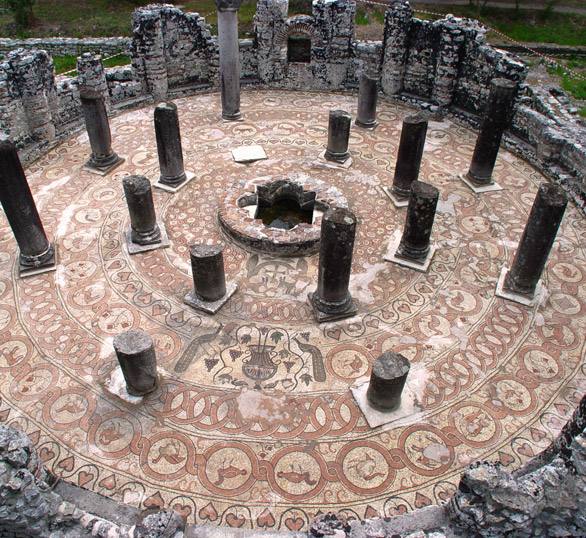Pick up group at Tirana airport - transfer to Hotel. We take a walking tour of the capital and visit the National Historic Museum with a wide range of archaeological artefacts from different excavations sites in the country. Overnight in Tirana.
After breakfast we drive to Shkodra the most important town of north Albania and one of the oldest in the country. It is thought to have been founded around 4th century B.C. and it was the centre of the Illyrian Tribe of Labeat. In the 3rd century B.C. it became the seed of the best known Illyrian Kingdom under Pleurat and Agron, who were two of the noteworthy kings who strengthened the Kingdom. Teuta, the Queen after the death of Agron fought and lost the Illyrio-Roman Wars during 221-219 B.C. succumbing to Roman rule, while her successor King Gent, re-ignited the anti-roman campaigns but finally was defeated at Shkodra in 168 B.C. We will visit the Rozafa Castle thought to have been rebuilt during Venetian rule in the 14th century over the previous foundations of the Illyrian castle, which served all the above mentioned Kings. Spectacular views all around can be enjoyed from the castle.We will also visit the Archaeological Museum situated in a traditional house of Ottoman architecture, where pavilions are small but very interesting and show the importance of this town back in time, which minted its own money. Afterwards we take a short walk in town through the nicely restored pedestrian area of Italian architectural influences and have lunch in a very characteristic restaurant. (optional) Afterwards depart for Kruja, the capital of Albania during the resistance against the Turks under Scanderbeg, who is our national hero and was a great leader that defeated the Turks in 25 battles. After visits of the Scanderbeg Museum and the Old Bazaar, we make our way just down below Kruja, to Zgërdhesh. Here is the ancient site of Albanopolis thought to have been the centre of the Illyrian tribe of Albani from which the country took its name hence becoming Albania. Only a 90 meter long fragment of the imposing wall survived, and can be seen at the lower part of the hill. There are also remains of three rectangular Illyrian watchtowers, which are thought to have been built in the 4C BC: after the visits return to Tirana for overnight.
Depart to Durres one of the oldest towns in Albania and the first and perhaps the most important of the Greek colonies in the country. It was founded at Epidamnus in 627 B.C. by Greeks from Corcyra (present-day Corfu) and Corinth. Greek and Roman authors called it the Admirable City" for its temple, statues, and other monuments. Fertile soil and a large seaport accounted for the colonys prosperity and success in commerce. Growth brought to the lower classes wealth and a subsequent desire to have more of a government voice, leading to a civil war between the small ruling class (oligarchs) and most of the population. The people requested Corinth & assistance in battle, while the oligarchs sought aid from Corcyra. Corinth was allied with Sparta and Corcyra upon this request, applied for aid from Athens giving start to what was later known as the Peloponnesian War.However only a few remains remind us of this city’s glory days, mainly due to the fact that Durres has been continuously inhabited through time, therefore being transformed accordingly. We will visit some of the remains such as the Amphitheatre, forum and Archaeological Museum. After visits depart for Berat, one of the most visited and characteristic towns in Albania under the protection of UNESCO as a patronage of humanity for its architectural uniqueness. On the way we will pass by Kavaja’s Rock where Caesar camped his troops during the civil war with Pompeii. Close by is the field of Golem where the outcome of the war was actually decided. Afterwards we visit the Castle and the Onufri Museum. Berat castle is of particular interest as people still live within its walls in their traditional houses, as have their ancestors for centuries. The castle used to have over 40 churches of which 7 still remain including St. Mary’s church turned into Onufri Museum. Onufri was a famous Albanian Icon master painter of the 16th century who painted many orthodox churches in Albania and Greece, using a special red colour. Overnight in Berat.
On the way to Gjirokastra we stop to visit the ancient city of Byllis one of the largest cities in Southern Illyria. Despite being founded by Illyrians this city has been mentioned relatively late by historians and ancient geographers. In 49-48 B.C. the city surrenders to the forces of Caesar and served as a base for his large army. Around 270 B.C. the city was the centre of a koinon, a political organization of the time, covering about 20km2. Byllis became a Roman colony, during the first years of the dominium of Augustus, and its name became Colonia Iulia Augusta. During the Late Antique period several large Palaeo-Christian basilicas were constructed, all of them carrying lavishly decorated mosaics, some of which can still be admired today. We visit the site and afterwards lunch can be had either at Byllis or just before Tepelena. Proceed to Gjirokastra, a museum town built entirely of stone, proclaimed a UNESCO World Heritage site for this distinct architecture. Visit Ethnographic Museum, which is also the house the Albanian ex-dictator was born in and the town. Overnight in Gjirokastra.
In the morning we depart to the ancient city of Butrint - a UNESCO World Heritage site and considered by most as the best archaeological site in Albania and beyond. The city was first settled by Greek colonists and was continuously inhabited for centuries forming archaeological layers of passing civilizations, giving archaeologists the possibility to study continuity through time. It is situated in a beautiful peninsula among lush vegetation. The site has been occupied since at least the 8th century BC, although myths associated with its origins speak of the city’s foundation by Trojan exiles led by Aeneas. By the 4th century B.C. a walled settlement was established and the city became a successful cult site, dedicated to Aesclepius. Main monuments around Butrint would definitely include the elegant 4th century B.C. Greek theater with its fine cavea and Roman scaenae frons with a capacity of a. 1500 spectators, the associated Greek sanctuary of Asclepius, the line of Roman period courtyard houses and bath-houses, east of the theatre disposed around the forum, the ruins of the Triconch close to the Butrint canal, a large Byzantine baptistery with its intact mosaic pavement dating to the early 6th century A.D., the well-preserved 6th century basilica (refurbished in later medieval times), the ruins of a 2nd century A.D. nymphaeum immediately adjacent to the basilica, and the kilometres of high, imposing walls dating from Greek, Roman, Byzantine, and medieval occupations. This is a wonderful site to explore for archaeology enthusiasts, definitely worth spending a few hours. We return to Saranda for overnight.
After breakfast we depart for Vlora following the so called Albanian Riviera. We stop at some characteristic villages along the coast and then continue to the ancient city of Amantia founded in the 5th century BC and covered an area of 13 ha. Amantia occupied an important defensive position above the Vjosa river valley to the east towards the Kurvelesh Mountains, and on the road to the coast and the Bay of Vlora. By the 3rd century BC, the Amantia town was strengthened economically and minted its own coins. The town of Amantia was surrounded with a walled enclosure roughly 2100 meters long. A large fort was built with two gates and two defensive towers in the north. Amantia remained a small urban centre and in early Christian times was the seat of a bishop. It is thought that Amantia may have been abandoned by the end of the 6C AD. The city of Amantia had its own acropolis and a Doric style temple dedicated to Aphrodite, constructed in the 3rd century B.C. The bestpreserved monument is the stadium which is 60 m long and 12.5 m wide. The stadium has 17 steps on one side and 8 on the other and could accommodate about 4000 people. After visits of the site return to Vlora and check in at the hotel. Afterwards we visit the original house where the independence document was signed in 1912 turned into “Independence Museum”. The house was the first seed of an Independent Albanian Government. At leisure for the late afternoon and evening in Vlora where we overnight.
After breakfast we depart for the ancient city of Apollonia one of the most important ancient centres in Roman times on the famous Via Egnatia. The famous Roman orator Cicero, astonished by the beauty of Apollonia named it in his Philippics, magna urbs et gravis - a great and important city. Established in the 7th century B.C., by Greek settlers from Corinth and Corcyra, the ancient city is located 11 km to the west of the city of Fier. Archaeological excavations have revealed that Apollonia achieved its zenith in the 4th - 3rd centuries B.C. In the first century B.C., Octavian Augustus studied philosophy there until he heard news of Caesar’s murder in the Senate and went on to become the next emperor. Visit the city and an Orthodox monastery turned into archaeological museum. Afterwards we visit the Monastery of Ardenica built in the middle ages of particular interest due to the beautiful frescoes of Kostandin Shpataraku and the Zeografi brothers. Scanderbeg the Albanian National Hero was married at the chapel of this monastery hence increasing its importance in Albanian history. Continue on to Durres for overnight.
After breakfast, free to explore until time of transfer to Airport. End of our services.

